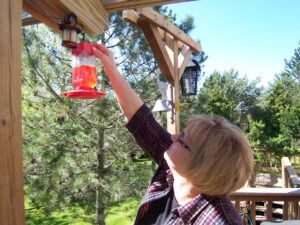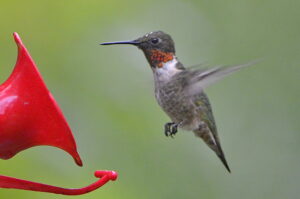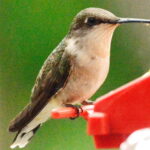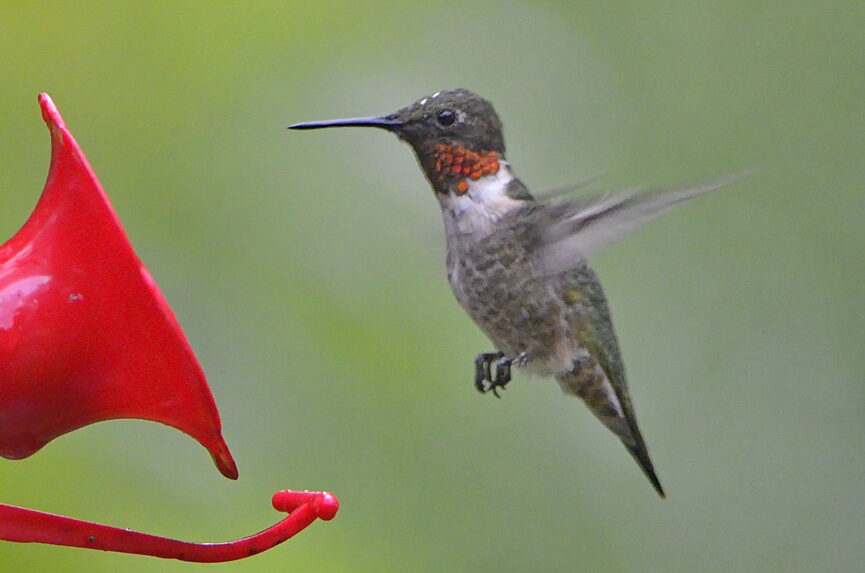Several years back, when my wife Ginny and I visited an Embera Indian village along a river in the Panama jungle during mid-March while on a side trip during a Caribbean cruise, we saw an amazing multitude of beautiful butterflies and dragonflies, as well as plenty of colorful hummingbirds, even involving many different species we had never seen before. Ginny purchased a delicate, wooden hummingbird that had been hand-carved by the Embera tribal leader, and this is because the hummingbird is a tiny migratory bird which is very dear to our hearts, and we look forward to their return near our home each spring. Yep, folks, Ginny can find places to go shopping just about anywhere, including very isolated locations in the jungle only accessed by dugout canoe!

Author’s wife, Ginny, caring for a hummingbird feeder
The first “ruby-throats” usually arrive at our home in late April or early May, just like annual clockwork. Ginny and I have learned to be prepared by having our hummingbird feeders out and waiting near the end of April, because the male Ruby-throated hummingbirds can arrive at any time to establish their breeding territories. The females will show up about 10 days later, usually by mid-May. We have our several hummingbird-feeders located on both our front patio and back deck, which allows for plenty of enjoyment in watching the colorful and highly animated tiny birds literally buzzing in and out, and occasionally even resting stationary for a short spell.
This close and frequent association with a continually growing number of hummingbirds to our home each summer has caused me to do some research and I’ve discovered there are often more questions than answers in this regard.

With wingbeats typically at 50 to 80 flaps per second and reaching flying speeds of 34 mph, hummingbirds literally possess the flying maneuvers, including the ability to fly backwards, which will put a modern-day helicopter to shame. Due to all this highly animated action, they have the highest metabolism of any warm-blooded animal, and to conserve energy at night, they will go into a torpor which is a state similar to hibernation. They also need to continually forage during the daylight hours.
Although the hummingbird is known for its love of nectar, it is truthfully a carnivore which has a primary diet of insects and spiders. Nectar provides the necessary energy to seek out insects and spiders, which represent the actual required protein. Hummingbirds also don’t suck nectar up but open their bill and lick it up with their long tongues, and are known for helping to pollinate various flowers, and a favorite hummingbird flower in our yard is trumpet-vine. They’re also always busy in our orchard when everything is blooming.
The most common hummingbird species which annually migrates to Michigan is the Ruby-throated, but other species show up in our state as well. The most common of these is the Rufous and it is like the Ruby-throat in appearance, but not as brightly colored, and I’ve had the occasional visitor migrating through. There is also the Green Violetear, the White-eared, and the even rarer seen Broad-billed (some of which I have yet to see and accurately identify).
I remember staying at a lodge right beside Lake Huron just north of Rogers City several years ago during a summer fishing excursion, and there were numerous hummingbirds visiting several feeders there. I’m not exactly sure what specie they were, but I do know none of them were Ruby-throated hummingbirds.
A part I enjoy about hummingbird watching is the flying courtship ritual the males perform shortly after the females arrive near our home. This entails the male hovering and making a vocal chitter-chattering noise and then going into a death defying steep dive to attract a female’s attentions. The very promiscuous males will mate with as many females as possible, and they have nothing to do with hatching or rearing the young. There are usually more females than males in a locale.
Personally I have yet to ever discover a hummingbird nest, but according to my research it is a cup-shaped affair constructed from a mixture of spider webs and plant materials, camouflaged with lichen and lined with plant down. It is slightly smaller than half a walnut shell and will usually contain no more than two pea-sized white eggs. The chicks hatch out naked and are fed a rich slurry that entails a mixture of insects and nectar which is regurgitated by the mother. The young will be ready to leave the nest in 5 to 6 weeks.
Ginny and I discovered long ago to use what is termed “oriole feeders” because we also have plenty of orioles (both Baltimore and orchard orioles) here annually, and hummingbirds and orioles will readily feed at the same feeder. We make our own “nectar” by mixing regular white sugar with water and bringing it to a boil to create a mixture which is less prone to spoiling and bacteria. The general recipe is one part sugar to four parts water but we prefer a richer mix of three parts water instead.
Although you can add red food color, we’ve discovered such isn’t necessary to attract hummingbirds and orioles. They will just as readily feed on the clear liquid as the red, just like they will feed on nectar from any colored flower. We always clean and sanitize our feeders prior to refilling them to prevent bacteria growth, which can harm the birds. While some folks take their hummingbird feeders down on Labor Day, we leave ours up well into October, until possible freezing becomes a problem. A regular amount of hummingbirds won’t begin migrating until mid or late September, and I’ve seen some obvious late migrants passing through in early October. The males will migrate first, followed later by the females and young.
The Ruby-throated hummingbirds will spend their winters usually anywhere from southern Mexico to northern Panama, where Ginny and I saw multitudes. Most will follow the coastline to get there, but some have been known to perform the 500-mile nonstop flight across the Gulf of Mexico, which is a truly amazing feat for such a small bird, although some have been known to take rest stops on oilrigs in the Gulf.
I always enjoy watching the newly arrived males establishing their breeding territories near our feeders, and this often involves some aggressive tactics of chasing each other around and resembling an aerial and miniaturized “dogfight”. The females usually arrive just over a week later and observing this very special hummingbird way of life drama firsthand certainly works for me.

Each and every spring, Ginny and I look forward to welcoming the hummingbirds returning after a long journey to reach our home, and while here, it is their home, too.
- Summertime plinking while dealing with the “red menacing horde “ - July 16, 2024
- Ladies Preparing To Take Aim - June 23, 2024
- The magical atmosphere of fishing during the “Dog Days” of summer - June 17, 2024

